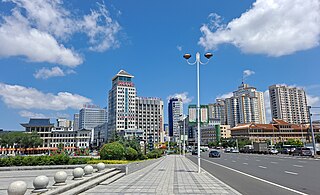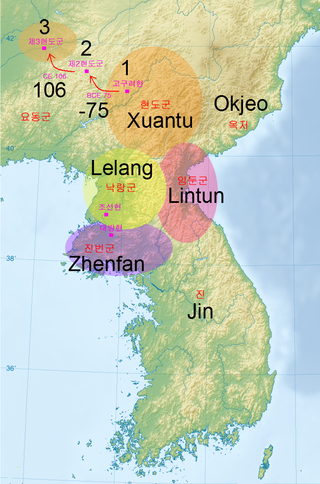
Manchuria refers to a region in Northeast Asia encompassing the entirety of present-day Northeast China or, historically, those areas combined with parts of the Russian Far East. Its definition may refer to varying geographical extents as following: the Chinese provinces of Heilongjiang, Jilin, and Liaoning but broadly also including the eastern Inner Mongolian prefectures of Hulunbuir, Hinggan, Tongliao, and Chifeng, collectively known as Northeast China. Historically included homeland of the Jurchens and later their descendants Manchus, which was controlled in whole by Qing China prior to the Amur Annexation in 1858–1860, when parts of the historical region were ceded to the Russian Empire. The two areas involved are Priamurye between the Amur River and the Stanovoy Range to the north, and Primorskaya which runs down the Pacific coast from the Amur mouth to the Korean border, sometimes including the island of Sakhalin, collectively known as Outer Manchuria or Russian Manchuria.

The Yanbian Korean Autonomous Prefecture is an autonomous prefecture in the east of Jilin Province, China. Yanbian is bordered to the north by Heilongjiang Province, on the west by Jilin's Baishan City and Jilin City, on the south by North Korea's North Hamgyong Province and on the east by Primorsky Krai in Russia. Yanbian is designated as a Korean autonomous prefecture due to the large number of Chaoxianzu living in the region. The prefectural capital is Yanji and the total area is 42,700 square kilometres (16,500 sq mi).
The Oroqen people are an ethnic group in northern China. They form one of the 56 ethnic groups officially recognized by the People's Republic of China. The Oroqen people are largely concentrated in the northern Chinese provinces of Heilongjiang and Inner Mongolia, which are home to 45.54% and 41.94% of the 8,259 Oroqen people living in China The Oroqen Autonomous Banner is also located in Inner Mongolia.

Manchuria is a region in East Asia. Depending on the definition of its extent, Manchuria can refer either to a region falling entirely within present-day China, or to a larger region today divided between Northeast China and the Russian Far East. To differentiate between the two parts following the latter definition, the Russian part is also known as Outer Manchuria, while the Chinese part is known as Manchuria.

A Koreatown, also known as a Little Korea or Little Seoul, is a Korean-dominated ethnic enclave within a city or metropolitan area outside the Korean Peninsula.

Wudaokou, whose name is a literal reference to the fifth level crossing of the Jingbao Railway, is a neighborhood in the Haidian District of North West Beijing, famous for its close distances to universities including Tsinghua University and Peking University.

Koreans in China includes non-Chinese nationalities such as South Korean and North Korean people living in Mainland China to study abroad or business, such as Thae Yong-ho. According to the Korean government, population of Korean with Chinese nationality, South Korean, North Korean in China is 2,109,727 in 2023. For this reason, ethnic Koreans with Chinese nationality or citizenship are termed Korean Chinese (朝鲜系中国人), Joseonjok, Chosŏnjok, and their official name in China is Chaoxianzu. They are the 13th largest officially-recognized ethnic minority group in China. Most of Korean Chinese live in Yanbian and Changbai within Jilin province. Significant populations can also be found in Heilongjiang, Liaoning, and Inner Mongolia Autonomous Region, with a sizable expat community in Shanghai.
A recognizable community of Chinese people in Korea has existed since the 1880s, and are often known as Hwagyo. Over 90% of early Chinese migrants came from Shandong province on the east coast of China. These ethnic Chinese residents in Korea often held Republic of China and Korean citizenship. The Republic of China used to govern the entirety of China, but now only governs Taiwan province and a minor part of Fujian province. Due to the conflation of Republic of China citizenship with Taiwanese identity in the modern era, these ethnic Chinese people in Korea or Hwagyo are now usually referred to as "Taiwanese". However, in reality most Hwagyo hold little to no ties with Taiwan.

Wangjing subdistrict is a subdistrict office in Chaoyang district, Beijing. It borders Donghu Subdistrict to the north, Laiguangying Area and Datun Subdistrict to the west, Jiangtai area and Jiuxianqiao Subdistrict to the east, and Taiyanggong area to the south.

London, the capital of England and the United Kingdom, has over recent decades become one of the most ethnically diverse and multicultural cities in the world.

Okryu-gwan or Okryu Restaurant is a restaurant in Pyongyang, North Korea, founded in 1960. South Korea analyst Andrei Lankov describes it as one of two restaurants, the other being Ch'ongryugwan, which have "defined the culinary life of Pyongyang" since the 1980s, and a "living museum of culinary art".
Beijing has many neighborhoods, some of which are new and others with a long history.
The registered population of Beijing Municipality consists of people holding either Beijing permanent residence hukou permits or temporary residence permits. The 2010 census revealed that the official total population in Beijing was 19,612,368, representing a 44% increase over the last decade. In 2006, the population of the urban core was 13.33 million, 84.3 percent of the total municipal population, which officially stood at 15.81 million. Urban sprawl continues at a rapid pace.

The Korean International School in Beijing is an international school in Wangjing, Chaoyang District, Beijing. It serves grades 1–12. It has instruction in Korean, Chinese, and English.
As of 2019 about 56,864 (South) Koreans reside in Shanghai. According to 2019 estimates about 79,609 Chaoxianzu (Joseonjok) live in Shanghai. South Koreans began moving to China after the 1992 establishment of diplomatic relations between South Korea and the People's Republic of China. Most South Koreans migrated to Shanghai due to business reasons.

Metro Detroit has the following ethnic groups:

The Korean People's Association in Manchuria was a self-governing autonomous prefecture in Manchuria, populated by two million Korean refugees. Following the Japanese occupation of Korea, many Korean anarchists had fled over the border into Manchuria, where they began organising a network of mutual aid for displaced Koreans in the region. Together with some Korean nationalists, they established the KPAM in order to provide food, education and self-defence to its members. Before long, the association found itself under attack by both Korean communists and Japanese imperialists, who assassinated their leadership. The Japanese invasion of Manchuria put an end to the anarchist experiment, with many of its members fleeing to China in order to fight against the Japanese Empire.

Lintun Commandery was a commandery established in the Korean peninsula by the Chinese Han dynasty. Lintun Commandery was one of the Four Commanderies of Han along with Lelang Commandery, Xuantu Commandery and Zhenfan Commandery.

Datun Subdistrict is a subdistrict on northwest of Chaoyang District, Beijing, China. It borders Aoyuncun Subdistrict to the north and west, Laiguangying Township and Wangjing Subdistrict to the east, Yayuncun and Xiaoguan Subdistrict to the south. As of 2020, its population was 132,457.


















